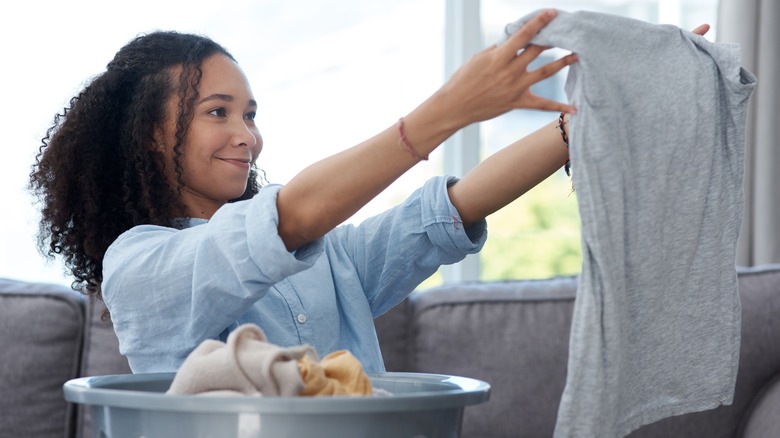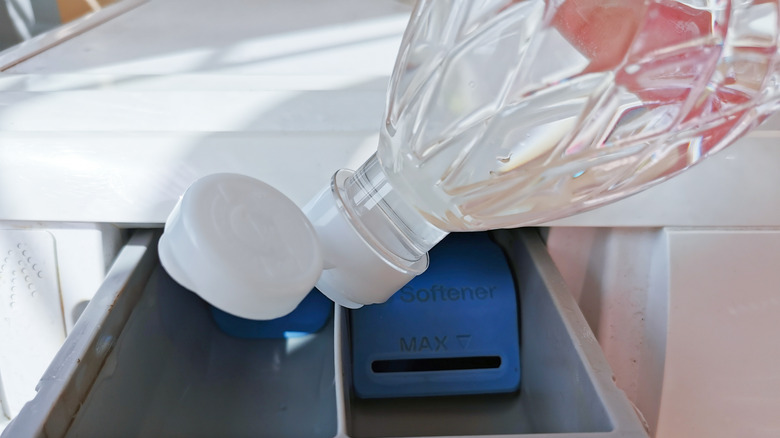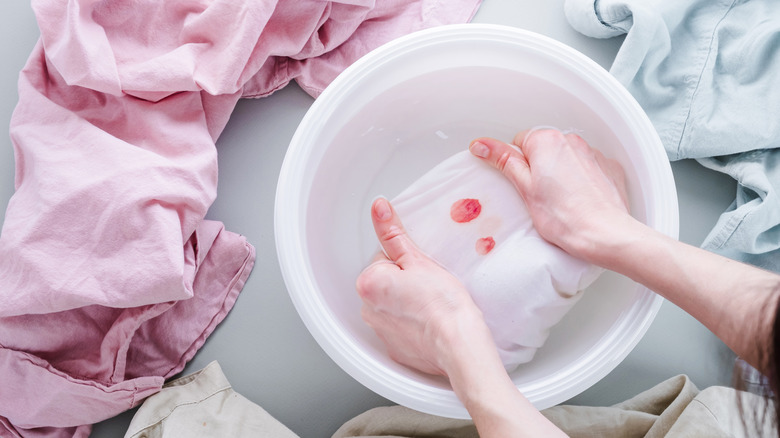Vinegar Vs. Hydrogen Peroxide: Which Is Better For Stubborn Laundry Stains?
Yellow sweat stains, red wine spills, brown dirt marks, and every other color soil under the sun can turn a simple laundry day into a pretreat, soak, rinse, and repeat disaster. Reaching for household products to take us out of our misery is usually our go-to solution. Vinegar and hydrogen peroxide can be the answer to get rid of the toughest laundry stains; however, which is better when it comes to fighting laundry woes? In an exclusive House Digest interview, we spoke to Zach Pozniak, co-owner of the luxury dry cleaning service, Jeeves NY, and co-author of The Laundry Book: A Complete Guide to Caring for Your Clothes and Linens. He shared that each product serves its own purpose and one doesn't necessarily outweigh the other.
"Vinegar is great for food stains and as a fabric softener, while hydrogen peroxide excels at tackling tougher stains and disinfecting," Pozniak said. "Depending on the type of stain and fabric, you may choose one over the other or even use them in combination for optimal results." So you might want to make space for both of these cleaners in the laundry room.
Vinegar eliminates stains and softens fabrics
"Vinegar is effective at removing stains from laundry due to its acidic properties, which help break down and dissolve various types of stains, particularly those from organic materials like wine, coffee, and tea," Zach Pozniak exclusively told House Digest. Even rust and grass stains can be eliminated with vinegar — cleaning vinegar, to be exact. Ones used for cooking usually have an acidic concentration around 5%, which isn't potent enough to dissolve the soils. However, cleaning vinegar can have an acid content of up to 45%, which is strong enough to tackle stains as well as soft fibers. The acid is often added to the rinse cycle as a fabric softener replacement, and it's a great white vinegar laundry hack, especially since too much fabric softener leaves stains and residue on your garments.
"For effective stain removal, it's suggested to soak the stained item in vinegar for at least an hour before washing it according to the care label," Pozniak said. "Vinegar can also be used as a pre-treatment for stains. Applying it directly to the stain before washing can enhance its effectiveness." The acid is an inexpensive and eco-friendly solution to fight dirt and soften fabrics; however, if you use too much your clothing may end up with a sour odor. Plus, vinegar might not be effective against tough blood and sweat stains. For those soils, hydrogen peroxide is a better option.
Hydrogen peroxide disinfects and bleaches
There are a few reasons why you should be using hydrogen peroxide to clean your laundry. Zach Pozniak exclusively told House Digest, "Hydrogen peroxide acts as a form of oxygen bleach, which is color-safe and effective for removing stains." It can eliminate stubborn blood and sweat marks that vinegar can't. While being safe to use on colored fabrics, the formula also brightens your white clothing. Pozniak added, "It has antibacterial properties, making it useful for sanitizing fabrics in addition to stain removal."
Hydrogen peroxide is generally used after washing your items. The only exception is when it comes to blood stains. Then, the chemical solution is applied as a pre-treatment. "For best results, you can spray 3% hydrogen peroxide directly onto the stained area and let it air dry," Pozniak said. "This allows the oxygen to penetrate the fabric and lift the stain." However, you don't want to use the solution on garments labeled dry clean only as it can damage the fabric. On your non-dry-clean pieces, you can try vinegar as a spot treatment or pre-soak first, and if the stains persist, double down with hydrogen peroxide. Keep in mind, it may take multiple applications of hydrogen peroxide for old set-in stains to be completely gone. So don't give up after the first try.


